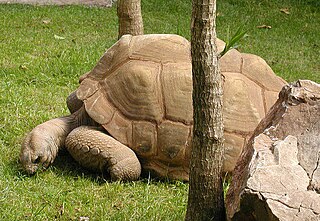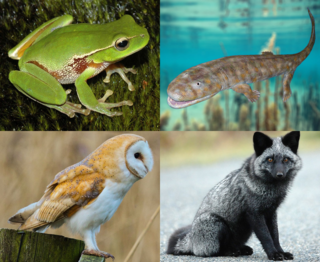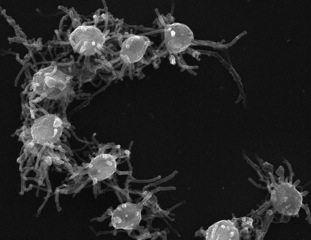
Cercozoa is a phylum of diverse single-celled eukaryotes. They lack shared morphological characteristics at the microscopic level, and are instead defined by molecular phylogenies of rRNA and actin or polyubiquitin. They were the first major eukaryotic group to be recognized mainly through molecular phylogenies. They are the natural predators of many species of microbacteria and Archea. They are closely related to the phylum Retaria, comprising amoeboids that usually have complex shells, and together form a supergroup called Rhizaria.

Neodiapsida is a clade, or major branch, of the reptilian family tree, typically defined as including all diapsids apart from some early primitive types known as the araeoscelidians. Modern reptiles and birds belong to the neodiapsid subclade Sauria.

The Cryptodira are a suborder of Testudines that includes most living tortoises and turtles. Cryptodira differ from Pleurodira in that they lower their necks and pull the heads straight back into the shells, instead of folding their necks sideways along the body under the shells' marginals. They include among their species freshwater turtles, snapping turtles, tortoises, softshell turtles, and sea turtles.

The Tetrapodomorpha are a clade of vertebrates consisting of tetrapods and their closest sarcopterygian relatives that are more closely related to living tetrapods than to living lungfish. Advanced forms transitional between fish and the early labyrinthodonts, such as Tiktaalik, have been referred to as "fishapods" by their discoverers, being half-fish, half-tetrapods, in appearance and limb morphology. The Tetrapodomorpha contains the crown group tetrapods and several groups of early stem tetrapods, which includes several groups of related lobe-finned fishes, collectively known as the osteolepiforms. The Tetrapodamorpha minus the crown group Tetrapoda are the Stem Tetrapoda, a paraphyletic unit encompassing the fish to tetrapod transition.

Alphaproteobacteria is a class of bacteria in the phylum Pseudomonadota. The Magnetococcales and Mariprofundales are considered basal or sister to the Alphaproteobacteria. The Alphaproteobacteria are highly diverse and possess few commonalities, but nevertheless share a common ancestor. Like all Proteobacteria, its members are gram-negative and some of its intracellular parasitic members lack peptidoglycan and are consequently gram variable.

In taxonomy, Roseobacter is a genus of the Rhodobacteraceae. The Roseobacter clade falls within the {alpha}-3 subclass of the class Alphaproteobacteria. The first strain descriptions appeared in 1991 which described members Roseobacterlitoralis and Roseobacterdenitrificans, both pink-pigmented bacteriochlorophyll a-producing strains isolated from marine algae. The role members of the Roseobacter lineage play in marine biogeochemical cycles and climate change cannot be overestimated. Roseobacters make up 25% of coastal marine bacteria and members of this lineage process a significant portion of the total carbon in the marine environment. Roseobacter clade plays an important role in global carbon and sulphur cycles. It can also degrade aromatic compounds, uptake trace metal, and form symbiotic relationship. In term of its application, Roseobacter clade produces bioactive compounds, has been used widely in aquaculture and quorum sensing.

Sagenista is a group of heterokonts containing the labyrinthulids and Eogyrea, a class of yet uncultured protists. Originally, it contained the Labyrinthulids and bicosoecids. However at present the bicosoecids have been removed, and Eogyrea were added, in order to make the group monophyletic.

Stegocephali is a group containing all four-limbed vertebrates. It is equivalent to a broad definition of Tetrapoda: under this broad definition, the term "tetrapod" applies to any animal descended from the first vertebrate with limbs and toes, rather than fins. This includes both the modern lineage of limbed vertebrates as well as a portion of the stem group, limbed vertebrates that evolved prior to the origin of the crown group. Members of the tetrapod stem group include the earliest limbed tetrapodomorphs such as Ichthyostega and Acanthostega, which evolved in the Devonian Period long before any modern form of tetrapod.

Opalinata is a superclass of non-phagotrophic heterokonts that unites the classes Opalinea and Blastocystea, and is the sister group to Opalomonadea.

Bigyra is a grouping of heterokont organisms. It includes Bicosoecida, Blastocystis and Labyrinthulida. It has also been described as containing Opalozoa, Bicoecia, and Sagenista.

Opalozoa is a subphylum of heterotrophic protists of the phylum Bigyra, and is the sister group to Sagenista. Opalozoans are non-photosynthetic heterokonts that are ancestrally phagotrophic but many times have evolved to be osmotrophic saprotrophs in the gut of vertebrate animals.

Filasterea is a proposed basal Filozoan clade that includes Ministeria and Capsaspora. It is a sister clade to the Choanozoa in which the Choanoflagellatea and Animals appeared. Originally proposed by Shalchian-Tabrizi et al. in 2008, based on a phylogenomic analysis with dozens of genes. Filasterea was found to be the sister-group to the clade composed of Metazoa and Choanoflagellata within the Opisthokonta, a finding that has been further corroborated with additional, more taxon-rich, phylogenetic analyses.

The Pelagibacterales are an order in the Alphaproteobacteria composed of free-living marine bacteria that make up roughly one in three cells at the ocean's surface. Overall, members of the Pelagibacterales are estimated to make up between a quarter and a half of all prokaryotic cells in the ocean.

Eotetrapodiformes is a clade of tetrapodomorphs including the four-limbed vertebrates and their closest finned relatives, two groups of stem tetrapods called tristichopterids and elpistostegalids. The clade was named in 2010 by Michael I. Coates and Matt Friedman, and is defined as "the node-based clade arising from the most recent common ancestor of Eusthenopteron and Ichthyostega plus all of its descendants". It thus excludes the basalmost tetrapodomorphs, such as the rhizodonts and megalichthyiforms.

Placidozoa is a recently defined non-photosynthetic lineage of Heterokonts.

Opisthosporidia is a superphylum of intracellular parasites with amoeboid vegetative stage, defined as a common group of eukaryotic groups Microsporidia, Cryptomycota and Aphelidea. They have been considered to represent a monophyletic lineage with shared ecological and structural features, being a sister clade of the Fungi. Together with the Fungi they represent a sister clade of the Cristidiscoidea, together forming the Holomycota.
Solenicola setigera is a species of marine stramenopile, and the only species classified within the genus Solenicola.
Wobblata is a paraphyletic grouping of all placidozoans except Opalinata. It unites the classes Placididea, Nanomonadea and Opalomonadea.
Nanomonadea is a class of biciliate phagotrophic, non-photosynthetic free-living opalozoans, coontaining the sole order Uniciliatida. This monophyletic group previously known as clade MAST-3 is characterized by a single hairless posterior cilium and absence of an anterior cilium.

Gyrista is a phylum of heterokont protists containing three diverse groups: the mostly photosynthetic Ochrophyta, the parasitic Pseudofungi, and the recently described group of nanoflagellates known as Bigyromonada. Members of this phylum are characterized by the presence of a helix or a double helix/ring system in the ciliary transition region.














